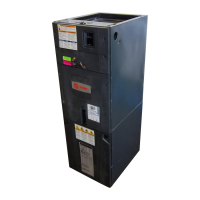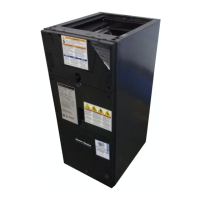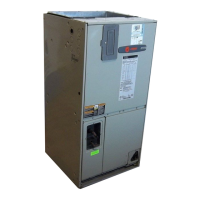39
Section 19. Sequence of Operation
19.1 Sequence of Operation
GAM5 Sequence of Operation:
Abbreviations
• TDR = Time Delay Relay
• EVC = Expansion Valve Control
• EEV = Electronic Expansion Valve
• YI = Y signal into the EVC from the comfort control
• Yo = Y signal out of the EVC from the comfort control
• OEM = Original Equipment Manufacturer
See unit, electric heat, and field wiring diagrams for ad-
ditional information.
Continuous Fan
IMPORTANT: If the indoor air exceeds 60% rela-
tive humidity or simply feels uncomfortably humid, it
is recommended that the indoor fan only be used in
the AUTO mode.
1. R-G contacts close on comfort control sending 24VAC
to the G terminal on the fan TDR
2. Low speed contacts close in the TDR and send
24VAC on terminal labeled “LOW’.
3. Blower motor will now run on low speed. Speed is
field selectable.
Heat Pump OD (cooling)
1. R-Y contacts close on the comfort control sending
24VAC to Y terminal on TDR and the YI (Y In) termi-
nal on the EVC.
2. R-G contacts also close on the comfort control send-
ing 24VAC to the G terminal on the TDR. (The com-
bination of 24VAC on terminals Y and G on the TDR
will close the high speed contacts of the TDR)
3. R-O contacts on the comfort control close sending
24VAC to the O terminal on the EVC. This signals
the EVC that the unit is in cooling mode. The EVC
will control the EEV to maintain the correct super-
heat.
4. Normally closed contacts on the EVC will pass 24VAC
to the Yo terminal providing power to the outdoor unit
control circuit
5. The blower motor will now run on high speed. Speed
is field selectable.
Heat Pump OD (heating)
1. R-Y contacts close on the comfort control sending
24VAC to Y terminal on TDR and the YI (Y In) termi-
nal on the EVC
2. R-G contacts also close on the comfort control
sending 24VAC to the G terminal on the TDR. (The
combination of 24VAC on terminals Y and G on the
TDR will close the high speed contacts of the TDR)
The blower motor will now run on high speed.
3. The combination of 24VAC on the Y terminal and zero
volts on the O terminal signals the EVC that the unit is in
heat-pump heating mode.
4. Normally closed contacts on the EVC will pass 24VAC
to the Yo terminal providing power to the outdoor unit
control circuit
5. The blower motor will now run on high speed
Cooling OD
1. R-Y contacts close on the comfort control sending 24VAC
to Y terminal on TDR and the YI (Y In) terminal on the
EVC
2. R-G contacts also close on the comfort control sending
24VAC to the G terminal on the TDR. (The combination
of 24VAC on terminals Y and G on the TDR will close
the high speed contacts of the TDR)
3. R-O jumper on the TDR sends 24VAC to the O terminal
on the EVC. This signals the EVC that the unit is in cool-
ing mode. The EVC will control the EEV to maintain the
correct superheat.
4. Normally closed contacts on the EVC will pass 24VAC
to the Yo terminal providing power to the outdoor unit
control circuit
5. The blower motor will now run on high speed
Electric Heating
1. R-W contacts close on the comfort control sending 24VAC
to the W terminal on the TDR. 24VAC is also sent to
EHC to energize the heat relay.
2. R-G contacts close on the comfort control sending 24VAC
to the G terminal on the TDR. (The combination of
24VAC on terminals W and G on the TDR will close the
high speed contacts of the TDR)
3. WJ contacts on the TDR close providing an interlock
circuit to allow the electric heat relays to operate.
The comfort control must be setup to control R-G contacts
with a call for electric heat. This closes the interlock
circuit and allows the heat relay circuit to be energized.
Optional Condensate Switch
1. An optional OEM condensate switch can be installed
within the unit. This switch is only available through the
National Distribution Center or Global Parts.
2. Switch contacts are normally open and close when water
level rises. The closed switch will interrupt current flow to
the Yo terminal and de-energize the OD unit.
3. Switch is only operational during cooling mode. Conden-
sate overflow is not operational during heating or defrost
modes.
Standard aftermarket condensate switches cannot be used
within the unit but can be installed exterior of the unit.
Switch should be wired in series with Yo wiring to the
OD unit.

